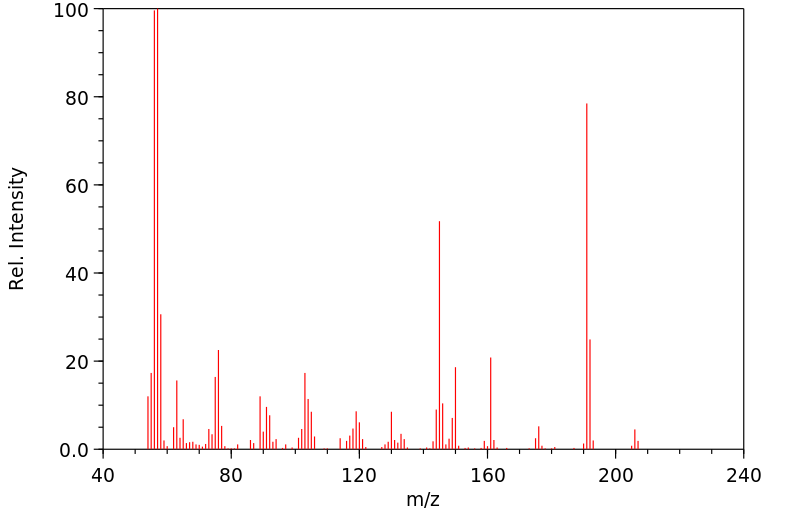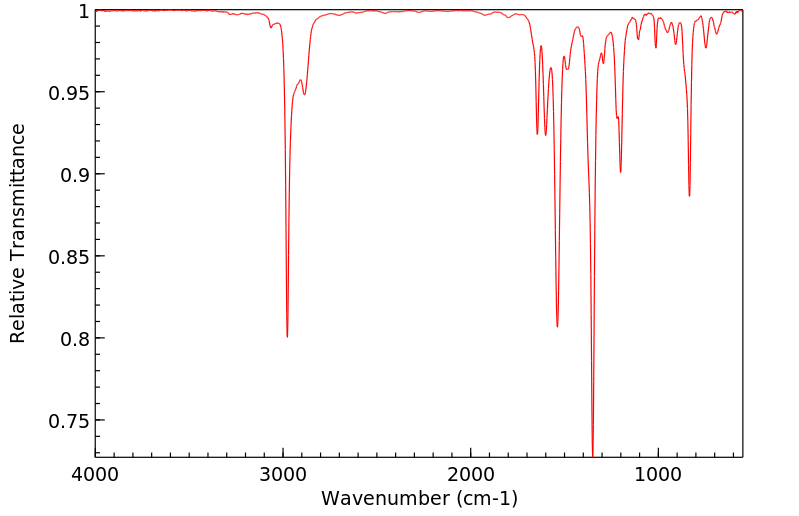p-硝基苄烯叔丁胺 | 718-36-5
中文名称
p-硝基苄烯叔丁胺
中文别名
对硝基亚苄基叔丁胺
英文名称
(p-nitrobenzylidene)(tert-butyl)amine
英文别名
p-Nitrobenzylidene tert-butylamine;N-tert-butyl-1-(4-nitrophenyl)methanimine
CAS
718-36-5
化学式
C11H14N2O2
mdl
MFCD00043780
分子量
206.244
InChiKey
BZCRPTQYJYKZDH-UHFFFAOYSA-N
BEILSTEIN
——
EINECS
——
-
物化性质
-
计算性质
-
ADMET
-
安全信息
-
SDS
-
制备方法与用途
-
上下游信息
-
文献信息
-
表征谱图
-
同类化合物
-
相关功能分类
-
相关结构分类
计算性质
-
辛醇/水分配系数(LogP):2.8
-
重原子数:15
-
可旋转键数:2
-
环数:1.0
-
sp3杂化的碳原子比例:0.363
-
拓扑面积:58.2
-
氢给体数:0
-
氢受体数:3
SDS
上下游信息
-
上游原料
中文名称 英文名称 CAS号 化学式 分子量 对硝基苯甲醛 4-nitrobenzaldehdye 555-16-8 C7H5NO3 151.122 —— N-(t-butyl)-N-p-nitrobenzylamine 3489-67-6 C11H16N2O2 208.26 -
下游产品
中文名称 英文名称 CAS号 化学式 分子量 N-叔丁基-Alpha-(4-硝基苯基)硝酮 N-tert-butyl-α-(4-nitrophenyl)nitrone 3585-88-4 C11H14N2O3 222.244 对硝基苯甲醛 4-nitrobenzaldehdye 555-16-8 C7H5NO3 151.122 —— N-(t-butyl)-N-p-nitrobenzylamine 3489-67-6 C11H16N2O2 208.26
反应信息
-
作为反应物:描述:p-硝基苄烯叔丁胺 在 2,6-二甲基苯酚 、 18-冠醚-6 、 potassium tert-butylate 、 间氯过氧苯甲酸 作用下, 以 二氯甲烷 、 叔丁醇 为溶剂, 反应 74.0h, 生成 2,6-二甲基-2,5-环己二烯-1,4-二酮参考文献:名称:Oxygen transfer from oxaziridines: a chemical model for flavin-dependent monooxygenases摘要:DOI:10.1021/ja00317a049
-
作为产物:描述:参考文献:名称:碳掺杂的WO 3-x超薄纳米片的便捷制备,用于胺的光催化需氧氧化摘要:由于亚胺在有机合成中的非常重要的通用应用,这是将胺氧化为亚胺的重要化学转化。在这里,我们开发了一种通过酸辅助一锅法合成碳掺杂的WO 3 x超薄纳米片的简便方法。碳掺杂的WO 3–x超薄纳米片在室温下可见光照射下,胺有氧氧化为相应的亚胺时表现出出色的光催化活性。高催化性能归因于出色的可见光吸收能力以及分子氧和底物的有效吸收。碳掺杂WO 3-x中存在的富氧空位超薄纳米片可能起重要作用,因为氧空位不仅改变了能带结构,而且还充当了催化位点,以通过光产物电子激活分子氧,从而产生超氧自由基。光产物空穴和超氧自由基都对胺的氧化起重要作用。DOI:10.1016/j.cattod.2018.11.013
文献信息
-
One‐Pot Synthesis of Diazirines and <sup>15</sup> N <sub>2</sub> ‐Diazirines from Ketones, Aldehydes and Derivatives: Development and Mechanistic Insight作者:Quentin Ibert、Madeleine Cauwel、Thomas Glachet、Tony Tite、Patricia Le Nahenec‐Martel、Jean‐François Lohier、Pierre‐Yves Renard、Xavier Franck、Vincent Reboul、Cyrille SabotDOI:10.1002/adsc.202100679日期:2021.9.21Broad scope one-pot diazirine synthesis strategies have been developed using two different oxidants depending on the nature of the starting material. In all cases, an inexpensive commercial solution of ammonia (NH3) in methanol (MeOH) was employed, avoiding the difficult use of liquid ammonia. With aliphatic ketones, t-butyl hypochlorite (t-BuOCl) was found to be the best oxidant whereas it is preferable
-
Synthesis of organophosphorus compounds via silyl esters of phosphorous acids作者:Kamyar Afarinkia、Charles W. Rees、John I.G. CadoganDOI:10.1016/s0040-4020(01)87899-6日期:1990.1The addition of trimethylsilyloxy phosphorus (III)derivatives generated in situ to imines at room temperature provides a mild selective and high yielding route to α-aminoalkylphosphorate and α-aminoalkylphenylphosphinate esters. Isocyanates and carbodiimides react similarly to give phosphonoureas and phosphonoguarnidines respectively aldehydes and ketones are much less reactive and cyanides are inert
-
Sulfonic peracids — III. Heteroatom oxidation and chemoselectivity作者:R. Kluge、M. Schulz、S. LiebschDOI:10.1016/0040-4020(96)00202-5日期:1996.4investigated thep-toluenesulfonic peracid (2) generated in situ in the oxidation of different types of compounds containing nitrogen and/or sulfur. The sulfonic peracid2 shows a remarkable chemoselectivity characterized by a preferred oxidation of sulfides to the sulfones in the presence of amines or olefins and a strong dependence on the nature of the amine in the competitive oxidation of olefins and amines.
-
Amphoteric Borylketenimines: Versatile Intermediates in the Synthesis of Borylated Heterocycles作者:Sherif J. Kaldas、Kowan T. V. O'Keefe、Rodrigo Mendoza-Sanchez、Andrei K. YudinDOI:10.1002/chem.201702008日期:2017.7.21We report the first synthesis of amphoteric borylketenimines from ethynyl N‐methyliminodiacetic acid (MIDA) boronate and sulfonyl azides via copper catalysis. In situ trapping of these intermediates with various nucleophiles provided access to novel borylated azetidimines, iminocoumarins, amides, iminooxetanes, and amidines. The described strategy based on borylketenimines offers high levels of chemo‐
-
Structure–Reactivity Relationship in the Frustrated Lewis Pair (FLP)‐Catalyzed Hydrogenation of Imines作者:Sebastian Tussing、Karl Kaupmees、Jan ParadiesDOI:10.1002/chem.201600716日期:2016.5.23The autoinduced, frustrated Lewis pair (FLP)‐catalyzed hydrogenation of 16‐benzene‐ring substituted N‐benzylidene‐tert‐butylamines with B(2,6‐F2C6H3)3 and molecular hydrogen was investigated by kinetic analysis. The pKa values for imines and for the corresponding amines were determined by quantum‐mechanical methods and provided a direct proportional relationship. The correlation of the two rate constants
表征谱图
-
氢谱1HNMR
-
质谱MS
-
碳谱13CNMR
-
红外IR
-
拉曼Raman
-
峰位数据
-
峰位匹配
-
表征信息
同类化合物
(βS)-β-氨基-4-(4-羟基苯氧基)-3,5-二碘苯甲丙醇
(S,S)-邻甲苯基-DIPAMP
(S)-(-)-7'-〔4(S)-(苄基)恶唑-2-基]-7-二(3,5-二-叔丁基苯基)膦基-2,2',3,3'-四氢-1,1-螺二氢茚
(S)-盐酸沙丁胺醇
(S)-3-(叔丁基)-4-(2,6-二甲氧基苯基)-2,3-二氢苯并[d][1,3]氧磷杂环戊二烯
(S)-2,2'-双[双(3,5-三氟甲基苯基)膦基]-4,4',6,6'-四甲氧基联苯
(S)-1-[3,5-双(三氟甲基)苯基]-3-[1-(二甲基氨基)-3-甲基丁烷-2-基]硫脲
(R)富马酸托特罗定
(R)-(-)-盐酸尼古地平
(R)-(-)-4,12-双(二苯基膦基)[2.2]对环芳烷(1,5环辛二烯)铑(I)四氟硼酸盐
(R)-(+)-7-双(3,5-二叔丁基苯基)膦基7''-[((6-甲基吡啶-2-基甲基)氨基]-2,2'',3,3''-四氢-1,1''-螺双茚满
(R)-(+)-7-双(3,5-二叔丁基苯基)膦基7''-[(4-叔丁基吡啶-2-基甲基)氨基]-2,2'',3,3''-四氢-1,1''-螺双茚满
(R)-(+)-7-双(3,5-二叔丁基苯基)膦基7''-[(3-甲基吡啶-2-基甲基)氨基]-2,2'',3,3''-四氢-1,1''-螺双茚满
(R)-(+)-4,7-双(3,5-二-叔丁基苯基)膦基-7“-[(吡啶-2-基甲基)氨基]-2,2”,3,3'-四氢1,1'-螺二茚满
(R)-3-(叔丁基)-4-(2,6-二苯氧基苯基)-2,3-二氢苯并[d][1,3]氧杂磷杂环戊烯
(R)-2-[((二苯基膦基)甲基]吡咯烷
(R)-1-[3,5-双(三氟甲基)苯基]-3-[1-(二甲基氨基)-3-甲基丁烷-2-基]硫脲
(N-(4-甲氧基苯基)-N-甲基-3-(1-哌啶基)丙-2-烯酰胺)
(5-溴-2-羟基苯基)-4-氯苯甲酮
(5-溴-2-氯苯基)(4-羟基苯基)甲酮
(5-氧代-3-苯基-2,5-二氢-1,2,3,4-oxatriazol-3-鎓)
(4S,5R)-4-甲基-5-苯基-1,2,3-氧代噻唑烷-2,2-二氧化物-3-羧酸叔丁酯
(4S,4''S)-2,2''-亚环戊基双[4,5-二氢-4-(苯甲基)恶唑]
(4-溴苯基)-[2-氟-4-[6-[甲基(丙-2-烯基)氨基]己氧基]苯基]甲酮
(4-丁氧基苯甲基)三苯基溴化磷
(3aR,8aR)-(-)-4,4,8,8-四(3,5-二甲基苯基)四氢-2,2-二甲基-6-苯基-1,3-二氧戊环[4,5-e]二恶唑磷
(3aR,6aS)-5-氧代六氢环戊基[c]吡咯-2(1H)-羧酸酯
(2Z)-3-[[(4-氯苯基)氨基]-2-氰基丙烯酸乙酯
(2S,3S,5S)-5-(叔丁氧基甲酰氨基)-2-(N-5-噻唑基-甲氧羰基)氨基-1,6-二苯基-3-羟基己烷
(2S,2''S,3S,3''S)-3,3''-二叔丁基-4,4''-双(2,6-二甲氧基苯基)-2,2'',3,3''-四氢-2,2''-联苯并[d][1,3]氧杂磷杂戊环
(2S)-(-)-2-{[[[[3,5-双(氟代甲基)苯基]氨基]硫代甲基]氨基}-N-(二苯基甲基)-N,3,3-三甲基丁酰胺
(2S)-2-[[[[[((1S,2S)-2-氨基环己基]氨基]硫代甲基]氨基]-N-(二苯甲基)-N,3,3-三甲基丁酰胺
(2S)-2-[[[[[[((1R,2R)-2-氨基环己基]氨基]硫代甲基]氨基]-N-(二苯甲基)-N,3,3-三甲基丁酰胺
(2-硝基苯基)磷酸三酰胺
(2,6-二氯苯基)乙酰氯
(2,3-二甲氧基-5-甲基苯基)硼酸
(1S,2S,3S,5S)-5-叠氮基-3-(苯基甲氧基)-2-[(苯基甲氧基)甲基]环戊醇
(1S,2S,3R,5R)-2-(苄氧基)甲基-6-氧杂双环[3.1.0]己-3-醇
(1-(4-氟苯基)环丙基)甲胺盐酸盐
(1-(3-溴苯基)环丁基)甲胺盐酸盐
(1-(2-氯苯基)环丁基)甲胺盐酸盐
(1-(2-氟苯基)环丙基)甲胺盐酸盐
(1-(2,6-二氟苯基)环丙基)甲胺盐酸盐
(-)-去甲基西布曲明
龙蒿油
龙胆酸钠
龙胆酸叔丁酯
龙胆酸
龙胆紫-d6
龙胆紫








